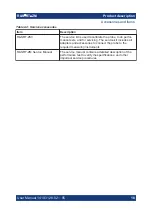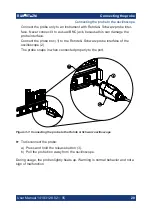
Connecting the probe
R&S
®
RT
‑
ZM
21
User Manual 1419.3128.02 ─ 05
3.3
Identification of the probe
When the probe is connected to the oscilloscope, the oscilloscope recognizes the
probe and reads out the probe-specific parameters.
The complete probe information is shown in the probe settings dialog. For more
information, refer to the user manual of your oscilloscope.
3.4
Connecting the probe to the DUT
This chapter describes how to connect the probe to the DUT using different
R&S
RT
‑
ZMA tip modules offered for the R&S
RT-ZM probe family. The various
tip modules are described and their use is explained. Note that you always need
a tip module. Measurements without any tip module are not possible.
The recommended configurations are designed to give the best probe perfor-
mance for different probing situations, to measure with confidence in the perfor-
mance and signal fidelity. Using the recommended connection configurations is
your key to making accurate oscilloscope measurements with known perfor-
mance levels.
The maximum non-destructive input voltage is ±30
V DC. A higher input voltage
can destroy the probe.
Probe frequency correction
For R&S
RT
‑
ZMAxx probe tip modules, typical S-parameters are determined and
stored in the oscilloscope. When the connected R&S
RT
‑
ZMA tip module is
selected in the oscilloscope probe menu, the appropriate correction parameters
are automatically processed by the Rohde
&
Schwarz oscilloscope. Correction
leads to a more accurate probe frequency response and an enhanced measure-
ment accuracy.
Supported oscilloscopes are listed in the data sheet.
3.4.1
Handling the probe tip modules and the probe amplifier
Handle the probe amplifier and connection pins carefully. Observe the following
procedures when connecting and disconnecting them.
Connecting the probe to the DUT
















































